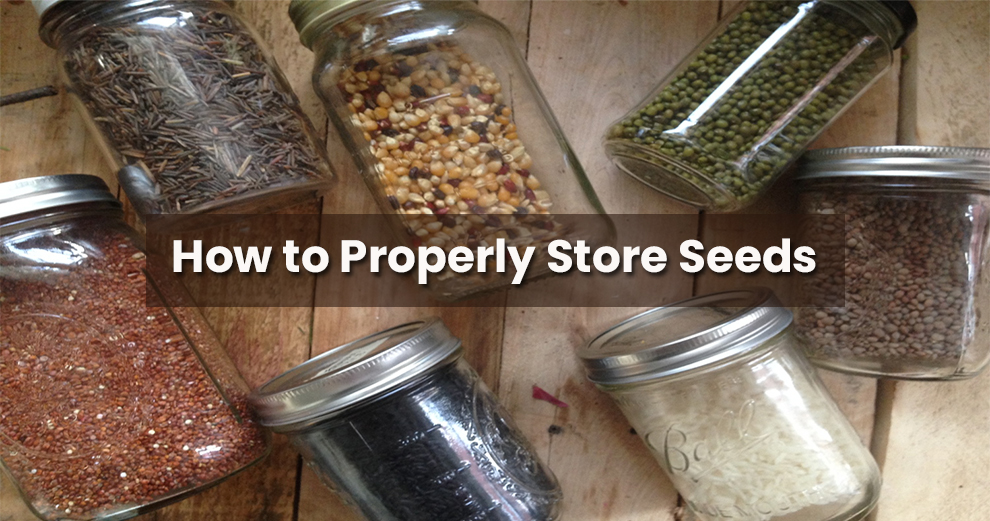How to Properly Store Seeds for Next Season?

Saving seeds for the next season is not new; our ancestors have been doing that for thousands of years. Seed saving allows the gardener to preserve the seeds of productive crops and grow them again the next year.
Today there are many sources from which gardeners can easily buy high-quality seeds, reducing the cost and saving a lot of time.
However, avid gardeners who want to preserve locally adapted seeds are turning towards saving and storing their own seeds. This practice promotes informal breeding by preserving seeds from plants with the best qualities like disease resistance, better and high-quality yield, and so on.
Although no professional degree is required for the proper saving of seeds, gardeners do, however, need to be very careful while planning the process and also have basic knowledge about how plants reproduce.
How Reproduction Works Through Seeds?
For a seed to be produced, pollination needs to occur, which is when pollen from the male parts of a flower is transferred to the female parts.
Plants that belong to the same species can pollinate each other, while it is difficult to pollinate plants that are of different species.
There are two methods of pollination in plants:
- Self-pollination
- Cross-pollination
Self-pollinating plants have flowers that consist of both the male and female parts. Such plants can pollinate themselves, and the seeds produced through this process produce plants identical to their parents.
Therefore, seeds of self-pollinating crops such as peas, peppers, tomatoes, and beans are very easy to save as they are unlikely to cross with other crops in the garden.
Cross-pollinating plants need pollination from other plants belonging to the same species. Such plants cannot self-pollinate as they have separate male and female flowers. Therefore, the seeds from cross-pollination produce plants that are different from their parent plants.
It is hard to save the seeds of cross-pollinating crops like corn and squash as they are capable of crossing with other crop varieties of the same species.
In such cases pollinating flowers manually or growing crops of just one variety is recommended to reduce the risk of the new crop being of low quality.
Viability of Seeds
The germination rate of seeds declines as they age. While most seeds remain viable for a year, proper storage can further extend that, so the seeds remain viable for even longer.
Seeds that are viable for 1-2 years include:
- onion
- okra
- pepper
- parsley
- parsnip
- sweet corn
Seeds that are viable for 3-4 years include:
- beet
- bean
- celery
- carrot
- eggplant
- leek
- pumpkin
- pea
- squash
- spinach
- turnip
- tomato
- watermelon
Seeds that are viable for 5-6 years include:
- basil
- endive
- lettuce
- radish
Tips for Proper Storage of Seeds
Cool and dry, as we know, the process of storing seeds for anything from vegetables to flowers is almost the same. It all started with saving the seeds first and collecting them once mature. And then, based on different types of seeds, the requirements also differ that are as discussed below:
A. Storage Temperature
If you want to preserve seeds in a proper manner, storing them away in your garage or any closet is not advisable. Although the temperature in such spots might be ideal for the seeds, extreme fluctuations in temperature can be very bad for them.
Whether you are planning to germinate your seeds using the new food technology such as the hydroponic system or simply straight to the ground, the temperature your seeds were stored would play an essential role in the germination.
Therefore, to prolong the life of your seeds, keep them in a place that is out of direct sunlight, dark, and cool with a temperature that remains below 4℃.
If you keep your seeds in cold storage, it is best to let the seed container come to room temperature before opening it. This prevents moisture from condensing around the seeds that are still cold.
B. Keep Seeds Dry
Before storing the seeds for the next season, you need to ensure they are completely dry. Although moisture is needed for the seeds to grow when you plant them, getting moisture around the seeds when they are ready to be stored means they can rot or suffer from frost.
This is especially true with vegetable and fruit seeds, as they are still wet when you collect them.
For properly storing seeds, it is advisable to let them dry completely and keep moisture-absorbing silica packets in the seed containers.
C. Protect the Seeds from light
To keep the seeds viable until next season, keeping them in opaque containers such as bags and envelopes is useful. When seeds are exposed to light, it can heat them up, rendering them useless.
D. Keep the Seeds Safe from Pests
Apart from moisture, light, and temperature fluctuations, insects and pests also shorten the life of seeds. To combat this, seeds need to be stored in airtight containers such as glass jars so bugs cannot damage them.
Conclusion
Collecting and saving seeds for the next season is a very effective and sustainable method that gardeners can use to keep growing plants that are difficult to find, and also to reuse the resources from their garden itself instead of buying from outside.
Most seeds need to be stored in a moisture-free, cool, and dim place. Although different seeds have their own shelf-life with proper storage techniques, gardeners can increase their life and make them last longer and plant them seasonally for new yield.
